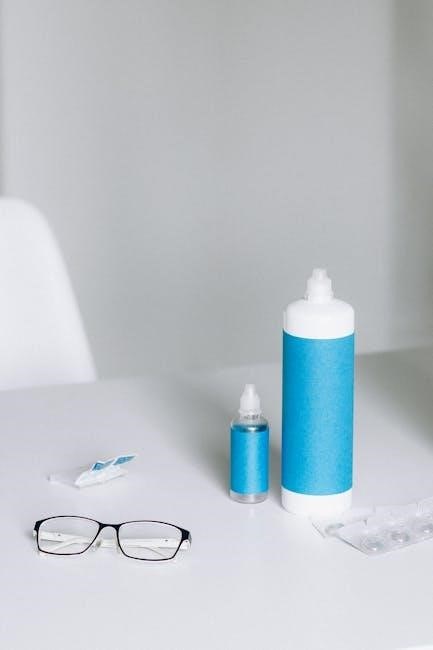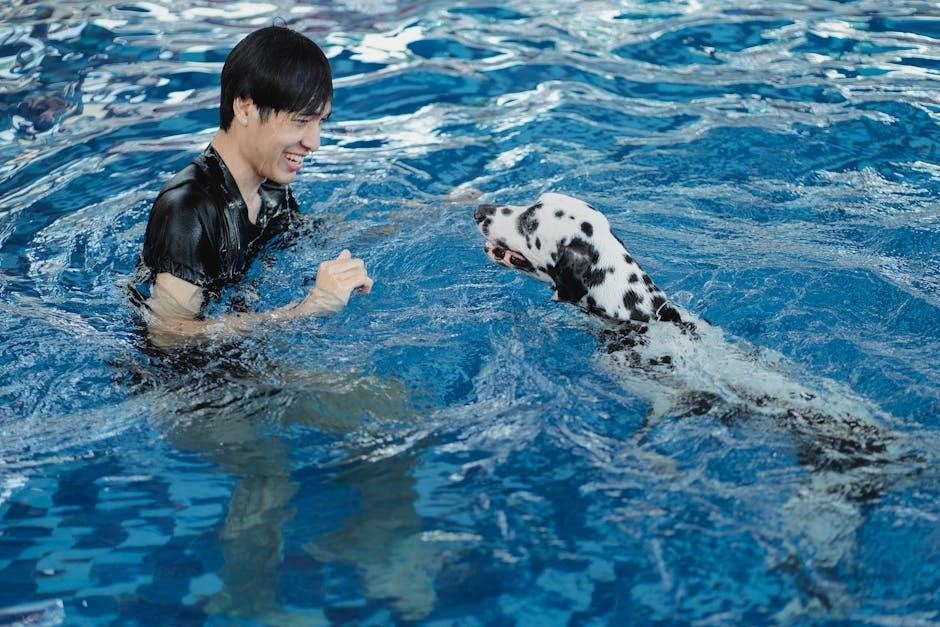This guide provides optometrists with a comprehensive overview of fitting Biofinity Multifocal lenses․ It covers key features, lens parameters, and a streamlined fitting approach, designed to simplify the process for presbyopic patients and optimize their vision and comfort․
Biofinity Multifocal lenses, manufactured by CooperVision, represent a significant advancement in contact lens technology for individuals with presbyopia․ These lenses are designed to provide clear vision at all distances – near, intermediate, and far – reducing the need for reading glasses or bifocals․ Biofinity Multifocal lenses are made from a silicone hydrogel material, known for its high oxygen permeability, ensuring excellent comfort and ocular health․ The lens material allows for extended wear, offering patients the flexibility of wearing them for up to six nights and seven days consecutively, with proper consultation and approval from their eye care professional․
The Balanced Progressive Technology incorporated into Biofinity Multifocal lenses ensures a smooth transition between different focal points, providing a natural and comfortable visual experience․ These lenses are designed with a center-near aspheric design, optimizing vision for near tasks while maintaining clear distance vision․ The unique design minimizes visual distortions and halos, allowing for seamless adaptation․ Biofinity Multifocal lenses are a popular choice among eye care practitioners due to their ease of fitting and high patient satisfaction rates․ The wide range of available parameters ensures a suitable fit for a variety of patients, making it an accessible option for those seeking multifocal vision correction․

Key Features of Biofinity Multifocal Lenses
Biofinity Multifocal lenses boast several key features that contribute to their popularity and effectiveness․ Firstly, the Balanced Progressive Technology is a standout feature, providing exceptional vision at all distances․ This technology ensures a smooth transition between near, intermediate, and distance vision, minimizing visual disturbances and allowing for comfortable adaptation․ The lenses are made from Comfilcon A, a silicone hydrogel material known for its high oxygen permeability․ This allows more oxygen to reach the cornea, promoting healthy and comfortable wear, even during extended wear schedules․
Another key feature is the Aquaform Technology, which helps retain moisture within the lens, keeping eyes hydrated and comfortable throughout the day․ This is particularly beneficial for patients who experience dry eye symptoms․ Biofinity Multifocal lenses also offer a wide range of parameters, making them suitable for a diverse range of patients with varying refractive errors and presbyopic needs․ The availability of different add powers allows for a customized fit, optimizing visual acuity for each individual․ Furthermore, the lenses are designed for monthly replacement, offering a convenient and cost-effective option for presbyopic patients seeking clear and comfortable vision․ The simplified fitting process makes it easier for eye care professionals to achieve successful outcomes․

Lens Parameters and Availability
Biofinity Multifocal lenses are available in a comprehensive range of parameters to accommodate a wide spectrum of patient needs․ The base curve is typically offered in 8․6 mm, catering to the average corneal curvature․ The diameter is standardized at 14․0 mm, ensuring consistent coverage and fit for most individuals․ The power range extends from -10․00D to +6․00D in 0․25D steps, allowing correction for both myopic and hyperopic prescriptions․
The add power, which corrects for presbyopia, is available in two options: Low (+0․50D to +1․50D) and High (+1․75D to +2․50D); This enables practitioners to tailor the near vision correction to each patient’s specific needs and stage of presbyopia․ Biofinity Multifocal lenses are designed for monthly replacement, providing a balance of convenience and cost-effectiveness․ They are packaged in boxes of six lenses, ensuring a six-month supply for each eye․ The lenses are readily available through authorized distributors and eye care professionals, making them accessible to patients worldwide․ The extensive parameter range and availability make Biofinity Multifocal lenses a versatile and practical choice for addressing the visual challenges of presbyopia․
Initial Lens Selection and Fitting Process
The initial lens selection for Biofinity Multifocal lenses begins with a thorough assessment of the patient’s refractive error and add power․ Start by determining the spherical equivalent and cylinder correction, if any, from the patient’s spectacle prescription․ Consider the patient’s age and lifestyle demands to estimate the appropriate add power․ Typically, younger presbyopes benefit from the Low add, while more advanced presbyopes require the High add․

Select trial lenses based on the spectacle prescription, adjusting for vertex distance if necessary․ Apply the lenses and allow the patient to adapt for approximately 15 minutes․ Evaluate the lens fit, centration, and movement on the eye․ The lens should exhibit adequate movement with blinking, typically around 0․5 to 1․0 mm․ Assess the lens centration to ensure it covers the pupil adequately․ Over-refract to refine the distance correction, checking binocularly with room lights on․ Evaluate near vision using a near acuity chart at the patient’s preferred reading distance․ Make adjustments to the add power as needed, considering the patient’s subjective feedback․ Document all findings and proceed to the next step of assessing visual acuity․

Assessing Visual Acuity After Fitting
After allowing the patient to adapt to the Biofinity Multifocal lenses for 15 minutes, a comprehensive assessment of visual acuity is crucial․ Begin by evaluating distance visual acuity under normal room lighting conditions, checking each eye monocularly and then binocularly․ Use a standardized Snellen chart or a comparable acuity chart․ Record the best-corrected visual acuity achieved with the trial lenses․
Next, assess near visual acuity at the patient’s preferred reading distance, typically around 40 cm․ Use a near acuity chart with appropriate optotypes․ Record the near visual acuity for each eye monocularly and then binocularly; If the patient reports difficulty with either distance or near vision, consider performing a careful over-refraction․ For distance vision issues, add -0․25D to the dominant eye to improve visual acuity․ For near vision issues, adjust the add power accordingly, up to +/- 0․50D․ Ensure that the patient’s visual comfort and clarity are satisfactory at both distance and near before finalizing the lens parameters․ Document all visual acuity measurements and any adjustments made to the lens power․
Troubleshooting Common Fitting Issues
Even with a careful initial fitting, some patients may experience issues with Biofinity Multifocal lenses․ Common problems include inadequate distance or near vision, fluctuating vision, lens discomfort, and dryness․ When troubleshooting, begin by thoroughly reassessing the patient’s visual acuity at both distance and near, as well as the lens fit on the eye․
If distance vision is suboptimal, consider refining the sphere power, adding -0․25D to the dominant eye․ For near vision difficulties, adjust the add power accordingly, up to +/- 0․50D․ Fluctuating vision may indicate lens instability or poor centration; evaluate the lens movement and consider a different base curve or diameter․ Lens discomfort or dryness can often be resolved by ensuring proper hydration and recommending appropriate rewetting drops․ In some cases, switching to a lens with a different material or water content may be necessary․ If problems persist, consider ruling out other underlying ocular surface issues and educating the patient on proper lens care and hygiene․ Document all troubleshooting steps and adjustments made․
Optimizing Vision and Comfort
Achieving optimal vision and comfort with Biofinity Multifocal lenses often requires fine-tuning after the initial fitting․ Assess the patient’s subjective experience and objective visual performance in real-world conditions․ If distance vision is compromised, consider a slight power adjustment, typically in -0․25D increments, prioritizing the dominant eye․ For near vision enhancement, small increases in the add power may be beneficial, carefully balancing the effect on distance vision․
Lens comfort can be improved through various strategies․ Ensure adequate lens hydration by recommending appropriate rewetting drops, especially for patients experiencing dryness․ Evaluate the lens fit and consider adjustments to the base curve or diameter to optimize centration and movement․ Educate patients on proper lens care and hygiene, emphasizing the importance of regular cleaning and disinfection․ In cases of persistent discomfort, explore alternative lens solutions or materials․ Regularly monitor the patient’s corneal health and address any underlying ocular surface issues․ A collaborative approach, involving open communication with the patient and careful consideration of their individual needs, is essential for maximizing success with Biofinity Multifocal lenses․
Biofinity Multifocal vs․ Other Multifocal Lenses
When choosing a multifocal lens, it’s important to understand the differences between Biofinity Multifocal and other options․ Biofinity Multifocal stands out due to its Balanced Progressive Technology, which provides a smooth transition between distance, intermediate, and near vision․ Compared to some lenses with distinct zones, this design minimizes visual disturbances․
The lens material, comfilcon A, also contributes to its advantages․ As a silicone hydrogel, it allows for high oxygen permeability, promoting corneal health and comfortable wear, unlike some hydrogel lenses with lower oxygen transmissibility․ Its wide range of parameters makes it suitable for many patients․
Other multifocal lenses may employ different designs, such as concentric rings or aspheric surfaces․ Each design has its own strengths and weaknesses in terms of vision quality and adaptation․ Some lenses prioritize specific distances, while Biofinity Multifocal aims for a more balanced visual experience․ Ultimately, the best choice depends on the individual patient’s visual needs, lifestyle, and fitting characteristics․
Care and Maintenance Instructions for Patients
Proper care and maintenance are crucial for the comfort, vision, and health of patients wearing Biofinity Multifocal contact lenses․ Patients should always wash their hands thoroughly with mild soap and water before handling the lenses․ Ensure hands are dry to prevent transferring contaminants․
Use only recommended multi-purpose solutions for cleaning, rinsing, and storing Biofinity Multifocal lenses․ Never use tap water, saliva, or homemade solutions, as these can introduce harmful microorganisms․ Rub and rinse the lenses gently to remove debris and protein deposits․ Store the lenses in a clean lens case filled with fresh solution․
Replace the lens case regularly, at least every three months, to prevent bacterial buildup․ Patients should adhere to the prescribed wearing schedule and replacement frequency․ Overwearing or reusing lenses beyond their recommended lifespan increases the risk of infection and discomfort․ If experiencing redness, irritation, or blurred vision, remove the lenses immediately and consult with an eye care professional․ Regular check-ups are essential to monitor lens fit and eye health․
Utilizing Fitting Guides and Calculators
Fitting guides and calculators are invaluable tools for eye care professionals when fitting Biofinity Multifocal contact lenses․ These resources offer a systematic approach to lens selection, streamlining the fitting process and improving the likelihood of a successful outcome for presbyopic patients․
Fitting guides typically provide step-by-step instructions on assessing patient needs, determining initial lens parameters based on refractive error and add power, and evaluating on-eye performance․ Calculators, often available online, can further assist in selecting the most appropriate lens power and fitting characteristics by inputting patient data․
These tools often incorporate troubleshooting tips for common fitting challenges, such as inadequate visual acuity or discomfort․ By utilizing these resources, practitioners can minimize chair time, optimize lens performance, and enhance patient satisfaction․ Staying updated with the latest fitting guides and calculators ensures that eye care professionals are employing the most current and effective techniques for fitting Biofinity Multifocal lenses, ultimately leading to better vision and comfort for their patients․


